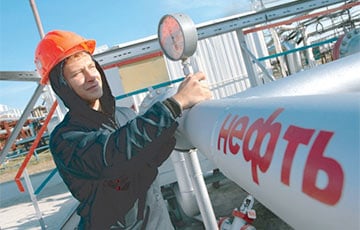Russia Prepares For Oil Price Collapse
10- 21.04.2025, 12:22
- 11,390

Oil is getting cheaper due to the US trade war.
Russian authorities are preparing for this year to be the year of cheap oil.
In its updated socio-economic development plan for 2025-2028, the Ministry of Economic Development lowered the average price of Urals in 2025 to $56 per barrel. This is the lowest value since 2020, when the demand for oil collapsed due to the pandemic, and the average annual price of Urals was $41.7 per barrel. Before that, Russian oil cost less in 2015-2016 ($51.2 and $41.9, respectively), The Moscow Times writes.
The new forecast is lower not only than the budgeted price of $69.7 per barrel, but also the so-called cutoff price of $60 per barrel, on the basis of which expenses are planned.
Oil and gas revenues above the cutoff price are sent to the National Welfare Fund (NWF), and if the actual cost of oil is below $60, the missing funds are taken from the NWF. As of April 1, it had 3.27 trillion rubles of liquid assets.
Oil is getting cheaper due to the trade war unleashed by the United States: experts expect at least a slowdown in the global economy, if not a recession. The cost of Brent fell below $60, and Urals fell below $50. In the first quarter, the budget's oil and gas revenues were 10% lower than last year, including 17% in March.
Every dollar by which the oil price falls costs the budget about 160 billion rubles in lost revenue per year, investment banker Evgeny Kogan estimated.
According to Raiffeisenbank analysts, if the average annual oil price falls to $55, the revenue shortfall that will have to be compensated for by selling currency from the National Welfare Fund will amount to 0.9 trillion rubles. If Russian oil prices fall by $10 per barrel (for example, from $65 to $55 per barrel), the economy will lose at least 0.5 percentage points of GDP growth, and the state budget will lose about 1 trillion rubles in revenue, all other things being equal, wrote T-Investments chief economist Sofia Donets.
However, not only the oil price has changed in the forecast, but also the dollar exchange rate. Taking into account the abnormal strengthening of the ruble in January-April, the Ministry of Economic Development has lowered its forecast for the average ruble exchange rate this year from 96.5 to 94.3 rubles per dollar. By the end of the year, the ministry expects the rate to be 98.7 rubles per dollar. Oil and gas tax rates are set in dollars, so in ruble terms they will also decrease in this scenario. In such parameters of the exchange rate and oil price, the federal budget deficit in 2025, all other things being equal, due to missing oil and gas revenues could be 2-2.5 trillion rubles higher than the Finance Ministry's plan, analysts at Tverdye Tsifry estimate.
This will be partly offset by other revenues. The Ministry of Economic Development raised its inflation forecast from 4.5% to 7.6% and did not reduce its economic growth forecast — 2.5% this year. Higher nominal GDP creates the preconditions for stronger non-oil and gas budget revenues in nominal terms, analysts at Tverdye Tsifry note.
The Ministry of Economic Development explains the unchanged GDP growth forecast by a good start to the year: “We consider this estimate to be quite realistic... The Ministry is looking at the first quarter trend — the economy is gradually slowing down, but we do not expect a sharp collapse. In order to achieve growth of 1.5% by the end of 2025, there must be a technical recession in some quarter — we do not count on this in the baseline scenario,” (quoted by Interfax).
Additional non-oil and gas revenues will most likely be spent — the budget rule allows the Ministry of Finance to do so. Alexander Isakov from Bloomberg Economics expected an increase in the spending plan by 1-1.2 trillion rubles due to increased debt servicing costs and excess non-oil and gas revenues. The shortfall in oil and gas revenues is especially sensitive given the significant reduction in the National Welfare Fund and the inflexibility of defense spending, Donets noted.
The budget law for this year plans a deficit of 1.2 trillion rubles (0.5% of GDP). Deputy Finance Minister Vladimir Kolychev said that with oil prices “closer to $60,” the deficit would be “larger,” but its increase would not exceed 1% of GDP (approximately 2 trillion rubles). Based on the results of the first three months, the deficit was 2.2 trillion.
In the following years, according to the forecast of the Ministry of Economic Development, oil prices will gradually recover, but will not grow much: $61 per barrel of Urals next year, $63 in 2027, and $65 in 2028.











